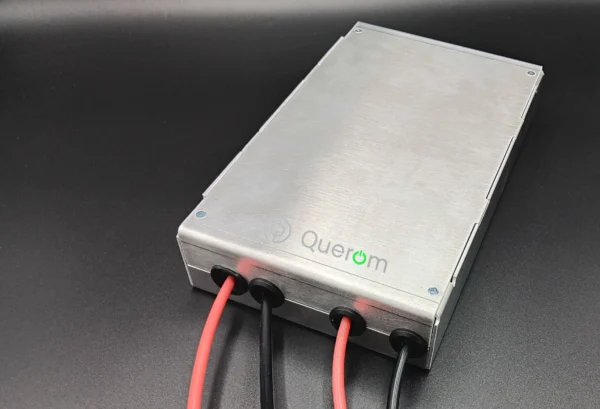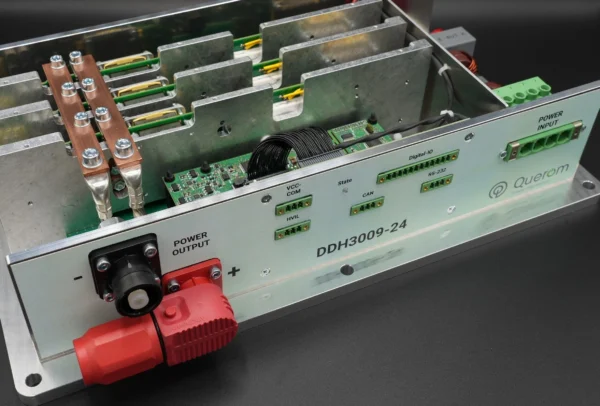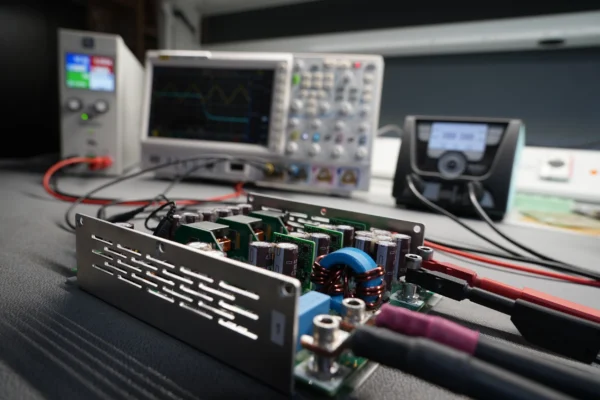Topologies of DC/DC Converter
Reading time: approx. 5 minutes – In this first of a total of two articles on DC/DC converters, you will learn interesting facts about the different modes of operation and topologies of DC/DC converters.

DC/DC converters are part of many electronic devices. They are necessary for the operation of almost all electrical products. DC/DC converters are electrical circuits that can convert a voltage applied to the input into a lower, higher, or inverted output voltage. Therefore, they are always used when an available supply voltage does not match the input voltage of the subsequent electronic components. Accordingly, many different versions of DC/DC converters with different specific characteristics are available on the market.
Functionality of DC/DC converters
The basic function of a DC/DC converter is that the DC voltage at the input is transformed into a rectangular AC voltage. This is done by opening and closing a switching element, for example a power transistor. Subsequent filtering, usually using inductance and capacitance, converts this AC voltage back to a DC voltage. The pulse width factor, defined as the duration of the controlled power transistor divided by the duration of the blocked power transistor, regulates the ratio of the input voltage to the output voltage.
The placement of reactances, i.e. inductances and capacitances in the circuit, determines the topology of the DC/DC converter. Active components that serve as switches, for example transistors and diodes, also play a role. In contrast to a linear voltage regulator, which works like an electronically variable resistor, DC/DC converters can achieve better efficiency. This is due to their switching operation and the subsequent filtering by low-loss reactive components.
Topologies of DC/DC converters
Basically, a distinction is made between a DC/DC converter with and without galvanic isolation. Galvanically isolated means the input and output of the DC/DC converter are connected by non-conductive coupling elements. This creates a potential separation. Depending on the application, this may be necessary for safety or measurement reasons. Galvanic isolation by means of a transformer or a coupled storage choke offers the possibility of selecting the magnitude and polarity of the converted voltage.
Examples of DC/DC converter topologies without galvanic isolation
Buck converter
The buck converter (DDL3050-48 – 3kW, 60A) uses a storage choke to filter the square-wave voltage chopped by the switching transistor. Consequently, the input voltage can be greater than or equal to the output voltage. One of its basic features is the transfer of energy to the output side during the transistor’s turn-on phase.
Boost converter
The boost converter (DDL2148-24 – 5kW, 100A) also uses a storage choke for filtering. It produces an output voltage that is higher or equal to the input voltage. It is characterised by energy transfer to the output during the switch-off phase of the switching element.
Buck-boost converter
The buck-boost converter (DDL4848-48 – 5kW, 100A), also with a storage choke, supplies an output voltage that is inverted relative to the input voltage. Its magnitude can be higher or lower than the input voltage. Here, too, the energy transfer occurs during the opening phase of the circuit breaker.
Examples of DC/DC converters with galvanic isolation
Fly-back converter
The fly-back converter, derived from the buck-boost converter, is mainly used in low-power applications. Specifically, those with a power of less than 300 watts. Energy is transferred via two coupled storage chokes, ensuring galvanic isolation.
Forward converter
The forward converter, belonging to the buck family, transmits energy by means of a transformer. To filter the output voltage, this topology requires a storage choke as well as the transformer. Typically, it is used in power ranges smaller than 500 watts. Depending on the requirements, a single-transistor flux converter with one transistor or a two-transistor flux converter with two can be selected. The two-transistor variant offers better utilisation of the transformer and is usable up to about 1 kW power.
Push-pull converter
Depending on the design, the push-pull converter is used in power ranges between 1 kW and over 10 kW. It belongs to the buck family and requires an output-side storage choke for filtering. Energy is transmitted via a transformer. A distinction can be made between half-bridge push-pull converters with two transistors and full-bridge converters with four switching transistors. The difference is that energy transfer to the secondary side can take place during all switching phases. This increases the achievable power density but leads to higher circuit complexity.
Resonant converter
A whole family of topologies is referred to as resonant converters. Their common characteristic is managing energy transfer with a series or parallel resonant circuit. This operation aims to reduce or avoid power losses when switching transistors by avoiding high voltages and/or currents at the switching moment. A significant advantage is the possibility of designing self-oscillating circuits that do not require external control. Thus, they are inexpensive and easy to build. Different resonant converters are used in a wide range of applications. These span from a few watts to over 10 kW, depending on the circuit and structure.
All topologies have specific properties, particular advantages, and always disadvantages. They are used in practice based on requirements. The challenge is to select the topology so that it is ideally suited to the application. This ensures the requirements are fulfilled in the best possible way.
More products and solutions from Querom.

Anton Mitterreiter
Product Manager
a.mitterreiter@querom.de
+49 8743 967197-4



